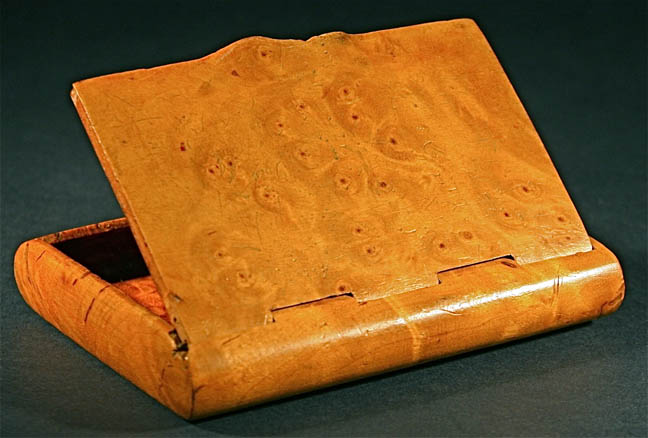

Title: Russian Burl Wood men's Cigarette Case by Peter Carl Faberge
Shipping: $18.00
Artist: N/A
Period: 19th Century
History: N/A
Origin: Central Europe > Russia
Condition: Good
Item Date: 1870s to 1920s
Item ID: 3491
A 19th 20th Century Antique Box, This is a Cigarette box. And an elongated hand carved Cigarette box with a hinged lid. Not marked. Russian fantasy wooden cigarette box known for the seamless hinge ! This was given away as a gift and made for only the upper class by Peter Carl Faberge. This was a limited edition style of Peter Carl Faberge, Comes to life in this extraordinary hand made men's cigarette box. Antique Russian Cigarette Case design by, Peter Carl Fabergé known as Carl Gustavovich: Fabergé May 30 1846 – September 24 1920) was a Russian jeweler, best known for the famous Fabergé eggs, made in the style of genuine Easter eggs, but using precious metals and gemstones and the worlds best materials. Antique Russian smoking wooden cigarette box Case. This is a Russian Burl wood cigarette box. Well-crafted, the case is made from only two pieces of exquisite burl wood. well-crafted. The dovetail hinge and edges of the lid fit together so perfectly that when closed, the case appears seamless. There are no straight lines when the box is closed, only soft rounded edges, making the case very pleasing to hold in the hands. The handle of the lid is elegantly curved, barely emerging from the edge, a subtle yet very functional design element which integrates beautifully with the design of the cigarette case. The hinge is so masterfully crafted and somewhat mysteriousâ€â€the dovetailing between the lid and the box is as perfect and expertly crafted as it can be, clearly made by a master wood worker, and appears to be held together by hidden wire pins at each end, as there are two tiny filled pin holes at each end, barely visible to the naked eye. The entire surface of the case, both inside and out, is continuous, with the lovely burl wood grain visible throughout. This was obviously made for and used by someone of very discriminating and refined taste and sensibilities not an object made for the common market, but rather made for the upper class. This is over 100 years old.
http://en.wikipedia.org/wiki/Peter_Carl_Faberg%C3%A9
Peter Carl Fabergé was born in Saint Petersburg, Russia to the jeweller Gustav Faberge and his Danish wife Charlotte Jungstedt. Gustav Fabergé’s father’s family were Huguenots, originally from La Bouteille, Picardie, who fled from France after the revocation of the Edict of Nantes, initially to Germany near Berlin, then in 1800 to the Baltic province of Livonia, then part of Russia. Carl and his younger brother Agaton were a sensation at the Pan-Russian Exhibition held in Moscow in 1882. Three years later, Czar Alexander III appointed him an official Court Supplier, as a reward for making him a splendid Easter egg to give to his wife. Thereafter, Fabergé made an egg each year for the Czar to give to the Empress Maria. The next Czar, Nicholas II, ordered two eggs each year, one for his mother and one for his own wife, Alexandra, a practice which continued from 1885 to 1917. He became the Czar’s Court Goldsmith in 1885. The Imperial Easter eggs were a sideline; Fabergé made many more objects ranging from silver tableware to fine jewelry. Fabergé’s company became the largest in Russia, with 500 employees and branches in Saint Petersburg, Moscow, Odessa, Kiev and London. It produced some 150,000 objects between 1882 and 1917. In 1897 the Swedish court appointed Fabergé Court Goldsmith. In 1900 his work represented Russia at the 1900 World’s Fair in Paris. In 1917, amidst the chaos of the October Revolution, he sold his shares in the company to his employees and fled Russia. He went first to Finland, with assistance from the British Embassy, and then to Wiesbaden, Germany making stops in Riga, Berlin, Frankfurt, Hamburg. Fabergé and his wife moved to Bellevue Hotel in Lausanne, Switzerland. When he died, he was buried beside his wife Augusta in the Cimetière du Grand Jas in Cannes, France.
Map and Origin Link